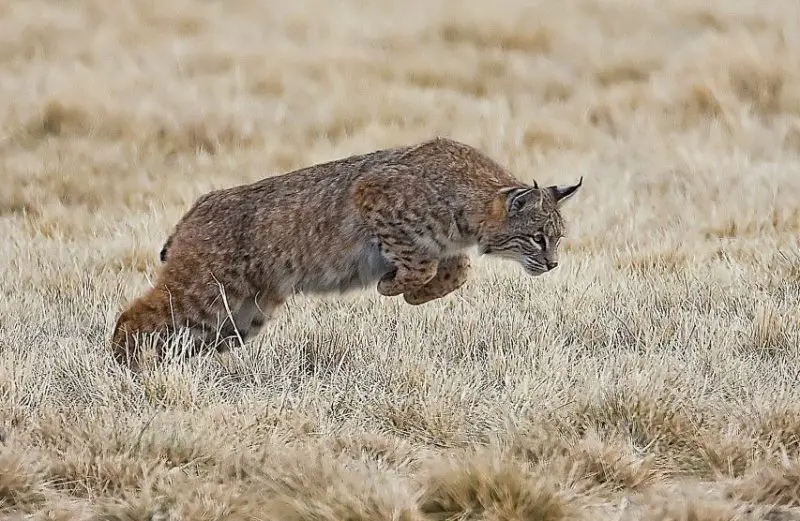When most people think of Nevada’s deserts, images of endless sagebrush, scorching sunlight, and rugged mountains often come to mind—not stealthy wildcats lurking among the rocks. Yet, the bobcat (Lynx rufus), one of North America’s most adaptable predators, thrives across this seemingly inhospitable landscape. These elusive felines have evolved remarkable survival strategies that allow them to endure the arid, sunbaked conditions of the Mojave and Great Basin deserts.
Bobcats are a symbol of resilience and adaptability. Their presence across Nevada’s harsh desert terrain reveals a fascinating story of evolution, stealth, and survival.
This expanded guide delves deeper into the secret lives of bobcats in Nevada’s deserts, exploring their adaptations, behaviors, hunting techniques, and evolving relationship with humans.
The Setting — Nevada’s Desert Environment

Desert Landscapes and the Bobcat’s Domain
Nevada is home to some of the most dramatic and varied desert landscapes in the United States. From the red sandstone cliffs of Red Rock Canyon near Las Vegas to the sprawling sagebrush plains of central Nevada, the state’s arid lands are teeming with life—and the bobcat is among its most skilled inhabitants. According to the Nevada Department of Wildlife (NDOW), bobcats are distributed throughout most of the state, particularly favoring rocky regions, canyon systems, and dry washes that offer shelter and hunting opportunities.
Their preferred habitats include desert shrublands, boulder-strewn hillsides, and rugged foothills where vegetation provides both cover and concealment. In these remote areas, bobcats can stalk prey while staying hidden from larger predators and human observers alike.
Challenging Conditions: Heat, Scarcity, and Shelter
Surviving in Nevada’s desert requires extraordinary adaptability. Summer temperatures often exceed 100°F (38°C), while winter nights can dip below freezing. Water is scarce, and food availability fluctuates seasonally. Bobcats meet these challenges by becoming masters of timing and energy conservation. They rest in shaded dens, rock crevices, or dense vegetation during the heat of the day and become most active during twilight hours.
This crepuscular behavior allows them to hunt when prey is active and temperatures are more tolerable. Their ability to find microhabitats that provide shade, moisture, and cover is essential to surviving the extremes of desert life.
Range and Territory
The range of a bobcat can vary dramatically based on the richness of its environment. In resource-poor desert areas such as the Mojave Desert or the Red Rock Canyon National Conservation Area, a single bobcat’s territory can exceed 100 square miles. In contrast, in prey-abundant foothills or riparian zones, territories may be much smaller. Males tend to occupy larger ranges that overlap with several female territories, while females defend smaller, exclusive areas where they rear their young.
Physical Adaptations for Desert Life
Camouflage and Build
Bobcats are perfectly equipped for stealth in the desert. Their short, dense coats—ranging from tan to grayish-brown—are patterned with dark spots and stripes that mimic the desert’s mix of rocks and vegetation. This camouflage is so effective that even experienced hikers may pass within a few yards of a bobcat without noticing it.
Their signature “bobbed” tail, measuring only four to seven inches, not only gives them their name but also breaks up their body outline, aiding concealment. Their muscular, compact frame is built for bursts of speed, enabling them to ambush prey or quickly escape predators.
Mastering Rugged Terrain
Nevada’s desert landscape is a maze of canyons, cliffs, and boulder fields—and bobcats navigate it effortlessly. Their powerful hind legs give them the ability to leap distances of up to ten feet. They often perch on elevated rock outcrops, using their vantage point to scan for prey below. This agility allows them to move silently through rocky terrain, minimizing energy use and maximizing hunting success.
Keen Senses for the Hunt
In a world where visibility and resources are limited, sensory precision determines survival. Bobcats possess exceptional hearing, aided by their tufted ears that can detect the faintest sound of movement. Their night vision is among the best in the animal kingdom, giving them a decisive advantage during nocturnal hunts. Combined with an acute sense of smell, these adaptations make the bobcat one of the desert’s most efficient predators.
Hunting, Diet, and Prey in Desert Nevada
Common Desert Prey
In the desert, bobcats are opportunistic feeders. Their diet primarily consists of rabbits, hares, ground squirrels, and rodents like kangaroo rats and packrats. They also prey on quail, doves, and other small birds that frequent desert oases and shrubs. When mammals are scarce, bobcats adapt by hunting reptiles such as lizards and snakes or scavenging carrion.
During wetter seasons, when small mammals are more active, bobcats thrive. In drier years, they must travel greater distances or switch to less energy-rich prey to survive.
Stealthy Ambush Hunters
Unlike wolves or coyotes that rely on pursuit, bobcats use ambush tactics. They remain motionless for long stretches near trails or burrows, waiting for the perfect moment to strike. With a swift and powerful pounce, they subdue their prey using sharp claws and a precise bite to the neck. This strategy minimizes wasted energy, an essential adaptation in the desert where food can be unpredictable.
Surviving Prey Fluctuations
Desert prey populations fluctuate drastically due to droughts and rainfall cycles. When rabbit or rodent populations crash, bobcats often expand their range or move closer to human settlements, where rodents are more plentiful. Their ability to switch diets and hunting strategies helps maintain their survival even during years of extreme scarcity.
Behavior, Social Life, and Reproduction
Solitary and Territorial
Bobcats are solitary creatures. They maintain defined territories marked by scent glands and urine sprays, avoiding unnecessary encounters with others of their kind. In the resource-limited desert, maintaining distance reduces competition and ensures each cat has enough prey to sustain itself. Males tend to roam widely, overlapping several female ranges, while females maintain smaller, exclusive territories that support their young.
Raising the Next Generation
Breeding usually occurs between January and May, timed so that kittens are born in spring when prey is more abundant. After a gestation period of around 60 days, females give birth to litters of one to six kittens. Dens are carefully chosen—often in rocky crevices, hollow logs, or dense brush—to protect against predators and temperature extremes.
The mother raises her kittens alone, providing food and protection until they are ready to hunt independently at around nine months. Juvenile bobcats may remain near their mother’s territory for a while before dispersing to find their own range.
Competing with Other Predators
Nevada’s deserts are home to a variety of predators, including coyotes, gray foxes, and mountain lions. While adult bobcats face few natural enemies, competition for prey can be intense. Coyotes are their most common rivals, and bobcats often avoid open areas to reduce encounters. Kittens, however, are vulnerable to predation from larger carnivores, eagles, and owls.
Hidden Facts About Nevada’s Desert Bobcats
Adaptations to Water Scarcity
Bobcats have evolved to thrive with minimal access to water. They obtain most of their moisture from the blood and tissues of prey and from dew that forms on vegetation at dawn. Nevertheless, they often establish territories near washes or desert springs that collect rainwater, ensuring at least occasional access to liquid sources during drought periods.
Flexible Activity Patterns
In the heat of the desert, timing is everything. Although primarily nocturnal, bobcats in Nevada frequently exhibit crepuscular behavior—becoming most active during dawn and dusk when temperatures are lower. This flexibility in their activity patterns allows them to synchronize with prey movements and conserve energy during extreme heat.
Living Near Humans
As urban areas like Las Vegas, Reno, and Henderson expand into the desert, bobcats have proven surprisingly tolerant of human presence. They are sometimes spotted near golf courses, suburban parks, and even backyards. While these encounters are usually brief and harmless, wildlife experts advise residents to secure trash, remove outdoor pet food, and supervise small pets to prevent conflicts.
Powerful Hunters Despite Small Size
Weighing between 15 and 35 pounds, bobcats are not large animals, yet their power is deceptive. They can leap nearly ten feet, climb trees to evade danger, and even take down prey larger than themselves, such as young deer. This strength-to-size ratio makes them one of the most formidable predators in Nevada’s arid ecosystems.
Massive Territory Ranges
Studies near Red Rock Canyon and the Mojave Desert reveal that male bobcats may roam over 50 to 100 square miles in search of prey and mates. This vast range and elusive nature make them difficult to study in the wild. Motion-sensor cameras and tracking collars have provided valuable insight into their movements, revealing how they navigate and survive across fragmented desert landscapes.
Conservation and Coexistence
Conservation Status
The bobcat is currently listed as a species of “Least Concern” by the International Union for Conservation of Nature (IUCN). In Nevada, bobcat populations are stable and regulated through managed hunting and trapping seasons under NDOW oversight. However, increasing urbanization and habitat fragmentation pose emerging threats, particularly in southern Nevada.
Coexisting with Desert Bobcats
As encounters between humans and bobcats increase, education and awareness are key. Homeowners can help maintain safe boundaries by removing food attractants, keeping small pets indoors at night, and using motion lights to deter nighttime visits. Bobcats rarely pose a danger to people and generally avoid confrontation.
Protecting Desert Habitats
Protecting bobcats ultimately means protecting the desert ecosystems they depend on. Conservationists emphasize preserving corridors that connect desert canyons, washes, and mountain foothills, allowing bobcats to move freely. Limiting off-road vehicle use, managing development, and protecting natural water sources are all crucial steps in maintaining healthy populations.
What You Can Do
Residents and outdoor enthusiasts can make a difference by respecting wildlife boundaries, reporting sightings to NDOW for research purposes, and supporting organizations that protect desert habitats. By fostering understanding and stewardship, humans can ensure these remarkable cats continue to roam Nevada’s wild deserts.
Myths and Misconceptions
“Bobcats Only Live in Forests”
Contrary to popular belief, bobcats are not confined to forests. They are found in deserts, grasslands, swamps, and even suburban areas. Their incredible adaptability allows them to thrive wherever prey and shelter are available, making Nevada’s deserts a perfect fit.
“Bobcats Are Dangerous to Humans”
Bobcats are elusive and prefer to avoid humans altogether. Attacks are almost nonexistent. Most sightings occur when a bobcat briefly passes through a neighborhood before retreating to the safety of the desert. Respectful observation from a distance is always the best policy.
“Bobcats Don’t Need Water”
While bobcats can survive extended dry periods, they still require moisture from food or occasional waterholes. Their desert resilience does not make them immune to drought; prolonged water scarcity can impact prey populations and force bobcats to expand their ranges.
A Glimpse into Desert Life: Real Examples
Dawn Hunt in Red Rock Canyon
In the early light of dawn, a bobcat crouches silently among Red Rock Canyon’s crimson stones. A desert cottontail emerges from the brush. In a flash, the bobcat lunges—swift, precise, and deadly. The entire event lasts seconds, a testament to the efficiency of one of Nevada’s most skilled hunters.
Suburban Sightings
In Reno’s desert suburbs, residents occasionally catch a glimpse of a bobcat padding across their yard. These fleeting encounters remind us that the wild still lives at the edge of modern life. Wildlife officials urge residents to appreciate such sightings as rare opportunities to witness nature up close.
Preserving Natural Corridors
Conservationists in southern Nevada are working to protect critical corridors that connect fragmented habitats. These natural passageways allow bobcats, foxes, and other desert wildlife to move freely between ranges without crossing dangerous roads or urban areas—a vital step for the long-term health of desert ecosystems.
The Future of Bobcats in Nevada’s Deserts
Climate Change and Adaptation
As climate change accelerates, Nevada’s deserts are projected to become hotter and drier. Bobcats may face increased challenges, including reduced prey availability and shrinking water sources. Researchers are monitoring these shifts closely to understand how bobcats adapt and whether their populations can sustain in the coming decades.
Expanding Human Footprint
Urban sprawl continues to reduce natural habitats across Nevada. Strategic urban planning that incorporates wildlife-friendly design—such as maintaining natural greenbelts and minimizing light pollution—can help mitigate the impact on bobcats and other native species.
Research and Citizen Science
NDOW and other organizations encourage citizen scientists to participate in wildlife monitoring programs. Motion-activated trail cameras, GPS tracking, and sighting reports are providing invaluable data on bobcat behavior and distribution. This collaborative effort is helping scientists better understand how these secretive cats coexist within modern desert ecosystems.
Conclusion
Bobcats in Nevada’s deserts are living proof of nature’s resilience. Through stealth, adaptability, and remarkable intelligence, they have mastered some of the harshest landscapes in North America. Whether prowling the canyons of Red Rock, the valleys near Reno, or the shadowed washes of the Mojave, these elusive cats remain symbols of wild Nevada—silent guardians of its vast desert wilderness.
The next time you venture into Nevada’s arid landscapes, pause to look closer at the dusty trail or rocky ledge. The faint imprint of a paw or a flicker of movement might reveal one of the desert’s most secretive residents—the magnificent bobcat.






